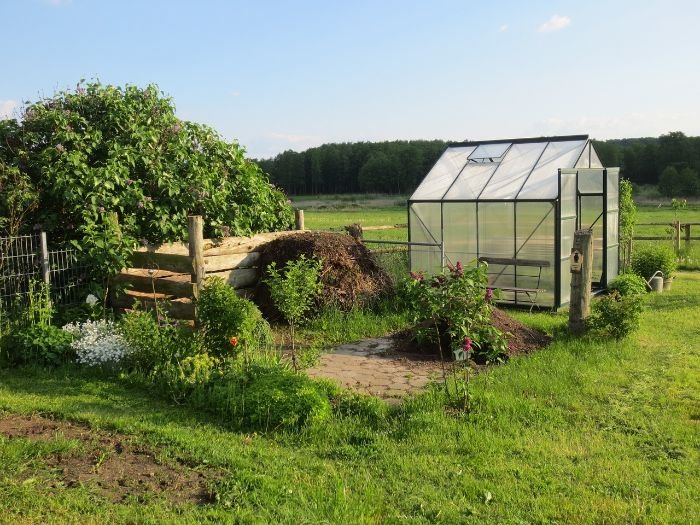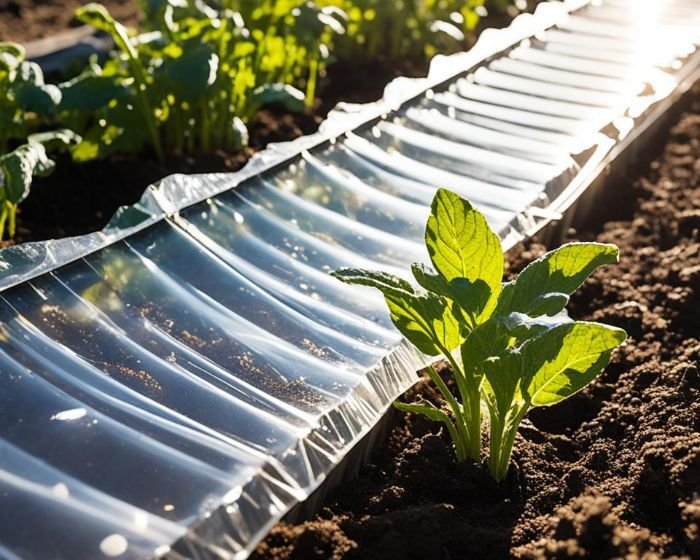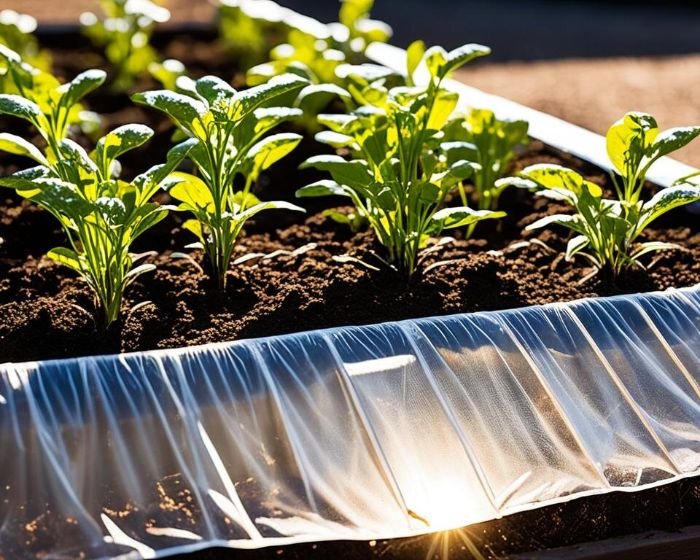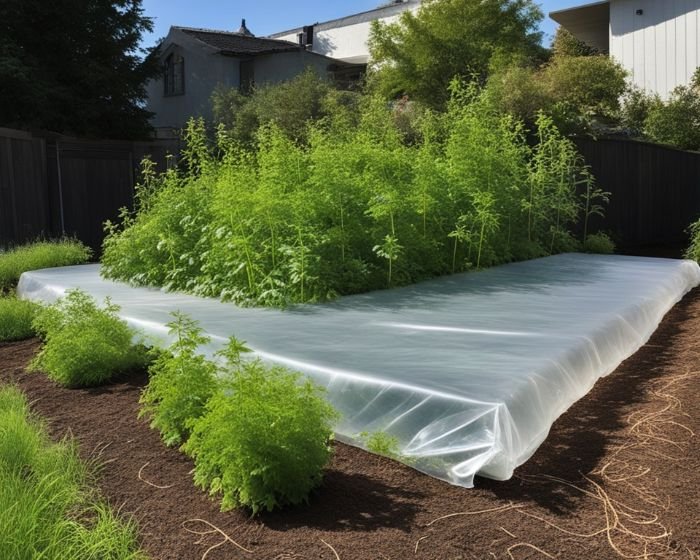Have you wondered how to fight garden weeds and pathogens without chemicals? Soil solarization is a key method. It’s becoming popular, especially in the Pacific Northwest’s nursery and greenhouse industries. People there are looking for chemical-free ways to kill weeds. They use special plastics and the sun’s heat to warm the soil. This kills many types of weeds and helps the soil stay healthy. So, this method is good for the earth and lets gardens grow well without harmful chemicals.
Key Takeaways
- Soil solarization is an eco-friendly weed management technique.
- This method is essential for sustainable agriculture, especially where chemical options are limited.
- It uses high solar radiation and specialized plastics to pasteurize soil.
- Effective in controlling a variety of soilborne pathogens and mesophilic weeds.
- Practiced widely in the Pacific Northwest’s nursery and greenhouse industries.
- Promotes ground health and reduces reliance on chemical treatments.
Table of Contents
What is Soil Solarization?
Soil solarization is a way to manage pests without chemicals. It relies on using the sun to heat the soil. This kills off pests and weeds, making the area better for plants.
Definition and Purpose
It’s an eco-friendly way that uses a clear plastic cover. This cover traps the sun’s heat to warm the soil. The heat kills weeds and pests, making the soil safer for plants. This process helps gardens and farms grow better by preventing weeds and diseases.
Benefits of Solarization for Garden Health
Soil solarization does a lot of good things for gardens. It boosts soil health and makes it more fertile. It also protects against soil erosion.
This method fits well with sustainable farming. It avoids chemicals, helping the environment. Plus, it’s good at controlling plant diseases.
How Soil Solarization Works
Soil solarization is a powerful way without chemicals to fight weeds and soil sickness using the sun. We learn how it works by knowing how hot it needs to get for pests to go away. The method makes sure the soil gets very hot, killing off harmful bugs and making the soil healthier.
The Science Behind Solarization
Soil solarization works like a greenhouse in your garden. It uses a plastic sheet to catch the sun’s heat on the ground. This makes the soil very hot. Placing the plastic on wet soil helps the heat sink deep. That’s how it heats the ground enough to kill bad bugs and keep the soil safe.

Temperature Requirements and Effects
To work, the ground needs to get really warm, between 100 to 122 degrees F. Many things like the kind of soil, the weather, and how wet the soil is can affect how hot it gets. Wet soil lets the heat move better through layers, making sure even deep parts are hot enough to kill pests. This makes the soil safer, with less weeds and diseases, making your garden a better place.
Preparing Your Garden for Solarization
Getting the soil ready is key for solarization to work well. You should do this in the warm parts of the year when there’s lots of sun and little rain. This makes sure the soil gets really hot, which is needed to kill weeds effectively.
Choosing the Right Time and Weather
Start your solarization in the high-sun months for the best results. More sun and longer days help a lot. Watch the weather and avoid rainy times. Rain can cool the soil and stop it from getting hot enough.
Necessary Materials and Tools
Next, gather everything you need for solarization. You’ll need clear plastic to cover the soil, tools for working the soil, and things to make the soil flat and keep it moist. Think about the type of soil and what plants are already there. This can affect how well solarization works.
- Clear plastic sheeting
- Soil cultivation tools
- Smoothing and irrigating equipment
By doing these steps and working with the right seasons, solarization will have a better chance of working. This will make your garden healthier.
Step-by-Step Guide to Soil Solarization
Soil solarization needs a structured plan to work well. This guide gives all the steps for a good soil treatment.
Soil Preparation
To start, clear the soil. Remove weeds, debris, and old plants. An empty surface helps the heat go deep into the ground. Follow a soil pasteurization guide for tips that fit your needs.
Laying the Plastic Sheeting
Next, place the clear plastic mulch. Pull it tightly over the soil. It must touch the ground everywhere. A tight cover keeps in the most heat for solarization.
Securing the Edges
It’s vital to keep the plastic down. Use soil or rocks around the edges. This makes sure there are no leaks. A tight seal means better weed control.
Monitoring and Maintaining
Keep an eye on the setup for best results. Check the plastic for tears often. Fix any issues right away.
Also, make sure the soil stays lightly wet. It helps the solarization work better. With proper care, this method can control weeds well.
Duration and Effectiveness
Soil solarization works best when you’re very careful about the time. Around four to six weeks is the sweet spot. This time lets the soil soak up enough heat. This helps kill weeds and bad germs in the soil.
Optimal Duration for Best Results
The success of soil solarization needs two main things. It needs to stay hot and a little wet. Keeping things just right makes this weed-killing method work best. The length of time to do this depends on where you are, the plastic sheet’s quality, and the weather.
Signs of Successful Solarization
You can tell soil solarization worked when you see fewer weeds and sick plants. The garden looks better without you having to weed as much. The soil also gets healthier. But, it needs to be hot for all of this to happen.
Controlling Weeds and Soil-Borne Diseases
Soil solarization is a mighty tool to control weeds and fight soilborne diseases. It increases soil heat to levels where many pests can’t live. It’s a great, non-chemical way to deal with these major farming issues.

Types of Weeds Controlled by Solarization
It’s very good at stopping yearly weeds. It warms the soil, stopping the seeds of many weeds from growing. This makes fields and gardens easier to keep free of weeds. Solarization makes the soil hard for these plants to live.
Soil-Borne Diseases Managed by Solarization
As for plant diseases, solarization also works well. It can cut down on diseases caused by pathogens like Verticillium dahliae and Phytophthora cinnamomi. Solarization goes deep in the soil to stop these bad germs. This helps make the soil healthier and your plants stronger.
Enhancing Soil Solarization
Improving soil solarization can make it work better against weeds and germs. One big way to do this is by adding organic stuff after solarization. This not only brings back good bacteria but also makes the soil better.
Combining Solarization with Organic Amendments
Adding organic stuff after sun treatment is very important. It puts back the needed nutrients and tiny life for the plants. It makes the soil healthier, diverse in small organisms, and more fertile. Things like compost, manure, and cover crops are great for the soil.
Using Clear vs. Black Plastic Sheeting
Picking the right plastic cover is key. Clear plastic is great because it holds more heat, sterilizing the soil deeper. Black plastic, however, is better at stopping weeds from growing on top.
Picking the best plastic cover helps soil solarization work its best. Clear plastic lets more sun in, heating the soil better and controlling more germs.
Post-Solarization Practices
After finishing soil solarization, it’s vital to continue caring for the soil. This ensures you keep enjoying the benefits for a long time. You should start by taking off the plastic and get the soil ready for new plants.
Removing the Plastic Sheeting
At the end of the solarization, carefully lift off the plastic sheeting. Try not to disturb the treated soil. Tossing the plastic correctly is important. It keeps the environment clean and sets up the land for more farming.

Preparing the Soil for Planting
With the plastic gone, it’s time to prep the soil for new plants. First, till the soil to loosen it up. Then add organic material to give it nutrients. This makes the soil perfect for planting. Following these steps helps in the soil’s health and growing future crops well.
Potential Drawbacks and Solutions
Soil solarization is a top choice for dealing with weeds and bugs without chemicals. But, it has its own tough points to handle. It needs the weather to be just right, and it struggles against some weeds.
Using plastic sheets also makes some people worry about the earth.
Limitations of Solarization
Solarization needs warm and sunny days to work well. In places that are cooler or have less sun, it might not get hot enough. This makes it hard for the heat to kill all the weeds, especially the ones with deep roots.
Mitigating Negative Effects
To fight these problems, we need smart and green ways to grow plants. Like choosing the best time of year for solarization when it’s hottest. Trying different materials for the cover can make it more eco-friendly.
Also, adding other ways to deal with weeds, such as pulling them out or planting a cover crop, can be a big help.
Conclusion – Embracing Non-Chemical Weed Control
Choosing soil solarization is a big step for sustainable farming. It offers a non-chemical way to fight weeds and diseases in the soil. This eco-friendly method is great for the environment. It boosts soil health without using harmful chemicals. So, it’s a win for the planet.
Soil solarization doesn’t just help now. It also improves soil health and keeps the natural balance. By using the sun, it gets rid of bad germs in the soil. This helps the earth stay healthy, making crops grow better. Organic farming and other kinds of sustainable farming like this method. It shows how much good it can do for our world.
The future of green farming is bright because of soil solarization. New ideas and ways to use this method keep coming. Soon, it will work even better and be even kinder to the earth. This is a great direction for farming. Someday, using methods like soil solarization will be normal. It will help our food and our planet both thrive.
FAQ
What is soil solarization and its purpose?
Soil solarization is a way to get rid of pests and weeds using the sun’s heat. You cover the ground with clear plastic. This traps the sun’s heat and makes the soil too hot for pests and weeds to live. It makes gardens and farms healthy without chemicals.
What are the benefits of soil solarization for garden health?
It makes the soil better by improving its chemistry and making it more fertile. It also stops the soil from washing away. This method fits well with natural farming techniques. It doesn’t use harmful chemicals.
How does soil solarization work scientifically?
The idea is simple. You cover the soil with clear plastic. The plastic traps the sun’s heat. This creates a hot environment that pests and weed seeds can’t survive in. It’s like a big greenhouse for the soil.
What are the temperature requirements for effective solarization?
The soil needs to get really hot, between 100 and 122 degrees Fahrenheit. The exact temperature depends on the type of soil and the weather. Wet soil heats up more easily. This helps the heat go deeper.
When is the best time to prepare the garden for soil solarization?
Choose the warmest and driest time of the year. This is when the sun is strongest. You need a lot of sun and little rain. It’s the best way to make sure the soil gets hot enough.
What materials and tools are necessary for soil solarization?
You will need clear plastic, tools for working the soil, and something to keep it flat. Make sure to know what’s in your soil and if any plants might shade it. This affects how well solarization works.
What types of weeds and soil-borne diseases are managed by solarization?
Solarization is good for getting rid of simple and hardy plants. It also fights some soil diseases. For example, it can kill off harmful fungi and bacteria.
How can soil solarization be enhanced?
Afterwards, add natural materials to the soil. This helps good bacteria and bugs come back. Plus, using the right color plastic can make it work better.
What post-solarization practices should be observed?
Take off the plastic and mix in more organic stuff. This strengthens the soil before you plant. Good dirt health means better plant growth.
What are the limitations of soil solarization and potential solutions?
Solarization doesn’t work as well in some climates. It’s also not great for getting rid of plants with deep roots. You can try using different kinds of plastic and pick the best time to start. This might help more plants, bugs, and diseases stay away.










